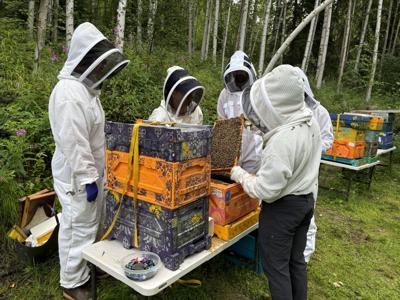Agriculture has always been promoted in the Tanana Valley, even in the earliest days of the camp that became known as Fairbanks. One interesting aspect of agricultural development in Alaska was the establishment of local apiaries. Beekeeping began in the Matanuska Valley and spread north to Fairbanks as part of the Agricultural Studies program at the University of Alaska. It is also interesting to note that until the advent of air mail, it was difficult to get live bees shipped to Alaska. By 1940, honeybees were becoming a noteworthy item in the local newspapers.
Fairbanks Daily News-Miner July 11, 1940
10,000 Fliers Sit Down on Week’s Field
Record Massed Flight of 2,000 Miles Ends at Fairbanks
Fairbanks’ prominence as a flying base gained added eminence Tuesday when 10,000 winged fliers from Shasta, California, set down on Weeks Field. Three days from point of origin to destination they came through in perfect condition — a massed flight worth remembering as the largest and longest of record in Uncle Sam’s domain.
Not army bombers nor pursuit fliers nor certified commercial pilots, are they, no, but busy little honeybees. And landing here they joined others of their kind who had preceded them making a colony totaling 100,000.
Consigned to J. G. Rivers, local attorney and secretary of the Fairbanks Chamber of Commerce, the last consignment made the long flight by airmail, flying the stretch from Seattle to Juneau by Alaska Clipper, and from Juneau by the PAA Electra.
After the journey of approximately 2,000 miles, they emerged from their little temporary woven wire hive lively as ever.
Including a queen bee, which was among the lot, they now are with the others of the Rivers Colony, busily engaged in seeking sweets from the fire flowers and other blooms so common in the region.
Mr. Rivers, who has had years of experience raising bees, is enthusiastic about his venture and prospects of adding another interesting and lucrative industry to that of Interior Alaska.
The bees received on Tuesday came in a small package, weighing but two pounds. The purchase price of the lot was $1.80, while the airmail postage on the package totaled $7.26, but Mr. Rivers is well satisfied with the postal cost because of the fact the bees came through so much more rapidly than otherwise possible, and without the loss of a single bee, whereas some shipped previously by ordinary mail succumbed before arrival. He now has two queen bees and may divide his army of honey makers into two divisions.
The bees are adapting themselves readily to their new environment and already are bestirring themselves over their average cruising range of four miles, bringing in the nectar.
The bees usually take off on their route flight at 8 a.m., and cruise until about 9 p.m., refusing to be lured to work a double shift despite the enticements of the bright and shining Midnight Sun that keeps other pilots on the wing at odd hours day and night.
Fairbanks Daily News-Miner July 21, 1941
Of recent date you have carried some “pro” with regard to the protection of a certain bear which feeds at the city dump. Here now is some “con” upon the same subject?
Personally, I am a supporter of wildlife protection, in fact, a champion of the nesting migratory bird. However, I have a homestead just beyond the city dump, and I have four swarms of honeybees there. And, I have a tolerable first hand knowledge of what a bear can and will do to honey bees or an isolated cabin. And this bear has been seen within 200 yards of my house.
Here is a question which I wish to ask the “pros.” Who will step up and insure me against the losses which I may sustain through a bear prowling around my house while I am away at work? If such a defender of the bear exists, let him speak quickly, for I expect to do my very best to kill any and all bears near my house on sight.
Fairbanks Daily News-Miner February 16, 1970
Here is a call to new beekeepers and others who expect to increase production this year. Bob Hayford, who operates a greenhouse just off the Steese Highway, has a supply of hives, foundations and other necessary equipment. Each year the supplies are sold out and transportation is such that orders cannot be filled without several months’ notice. Therefore, if you want to get started in bees, see Bob in the near future. There is nothing cheap about getting started in honey production. A minimum of $50 per hive must be spent to get started. Then a three-pound swarm of bees and a queen will cost another $10. The next year about the only expense will be the bees and an average hive will produce 50 pounds of delicious honey. Bees will be ordered cooperatively again this year so watch for the date when the orders are pooled. This will be in early March.
Fairbanks Daily News-Miner May 10, 1972
If this summer turns out to be a good year for flowers and other trees and shrubs which produce blooms, then the Tanna Valley beekeepers should produce 20,000 pounds of honey. Bees arrived last week in Fairbanks and today from California, ready to go to work.
Approximately 400 swarms of bees will be distributed by four local merchants. Those people who ordered three-pound swarms and a few of the four-pound orders arrived. The remainder four-pound, and five-pound orders will arrive on May 12.
Note: Today honey production is still going on here in Tanana Valley. We have both backyard personal use hives, as well as several commercial apiaries in the area. Most notable is the fireweed honey that is prized by locals and tourists alike.
This buzzy History Nugget has been brought to you by the Fairbanks Igloos of the Pioneers of Alaska. You can learn more at pioneersofalaska.org.










